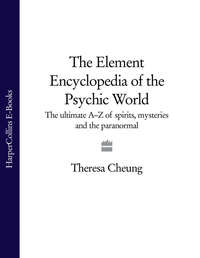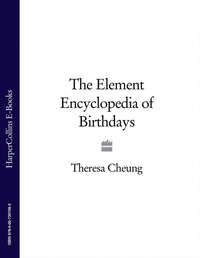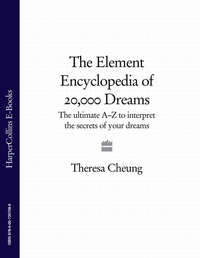
The Element Encyclopedia of Ghosts and Hauntings: The Complete A–Z for the Entire Magical World
Approximately a third of deathbed visions involve a vision of the afterlife, which is typically described as a beautiful garden. Some see apparitions there, others see streams, bridges and boats and other symbols of transition. Again the emotional response is one of great happiness and peace. The great majority of visions appear just before death with the patient dying shortly afterwards.
There are various natural explanations given for deathbed visions. Drugs, fever, disease, the brain suffering oxygen deprivation, hallucinations and wish fulfilment have all been given as possible causes. Although they are plausible explanations, Osis’s research showed clearly that deathbed visions are most likely to occur in the fully conscious and that medical factors do not trigger visions. Wish fulfilment is not a likely explanation either because visions appear both to those who believe and to those who do not believe in an afterlife, and also appear to those who want to recover and live. Finally there have also been reports by the living who are in attendance to the dying of clouds of silvery energy floating over the body, as well as take away apparitions and angels.
Deathbed visions are significant not just because they suggest the possibility of survival after death, but because they also demonstrate that the moment of transition to death should not be feared. If reports of deathbed visions are to be believed, for the person who is dying death can be a wonderful and beautiful experience.
DEATH OMENS
In folklore a death omen is a sign of an impending death. Every culture has its own unique death omens.
Death is frequently foretold by the appearance or behaviour of certain animals, insects or birds associated with the afterlife. Black birds – crows, owls, ravens, rooks – are often thought to be death omens when they appear in a village or cluster around a house. The howling of a dog or a black cat crossing the path are also thought to be signs that portend the death of someone nearby. Spiders are often associated with death, and according to American, British and European lore the deathwatch beetle, which makes a ticking or tapping sound during the summer months as it bores into wood, is considered the harbinger of a death in the family.
Death omens can be natural occurrences, for example the way wax drips from a candle, or accidents, such as a chair falling over backwards as a person gets up, or signs of nature, such as cloud shapes or star formations. They can also be supernatural occurrences, such as candles and lights that flicker in the night – see corpse candles and corpse lights – or the appearance of an apparition, such as the banshee, or a phantom coach with a headless coachman, or spectral black dogs, or other animals.
DECATUR HOUSE
The haunted house of one of America’s most celebrated naval captains in the war of 1812, Stephen Decatur. Located in Lafayette Square, Washington, DC Decatur House is said to be haunted by the ghosts of both Stephen and his wife, Susan.
Stephen Decatur moved to Washington with his wife in 1818 after the war ended. He was admired and even considered a presidential hopeful, but unfortunately for him, in 1807 he had served on the court-martial board of his friend, Commodore James Barron. Decatur had agreed with the rest of the board that Barron should be court-martialled, starting a feud that ended in Decatur’s death at Barron’s hands during a duel 13 years later in Bladensburg, Maryland (duelling being illegal in Washington). On 14 March 1820, the morning of the duel, Decatur was mortally wounded and taken home to die. His wife was so broken-hearted she could not bring herself to look at him or to live in the house after he had died.
A year after his death his apparition was allegedly seen looking sadly from the window where he had stood on the eve of his death. The window was walled up but this did not stop the ghost returning. Later sounds of a woman weeping – said to be Susan Decatur – were also heard.
Residents of Washington still report seeing Decatur’s spirit peering out of the second-storey window or slipping out the back door of his house with a black box under his arm, just as he had done on that fateful day of the duel.
DéJà VU
An expression of familiarity that is unexpected, déjà vu is the sensation of having been to a place or experienced a situation before. The French term for ‘already seen’ can apply to feelings, thoughts, places, dreams, meetings and living in general – whenever something familiar seemingly happens for the first time. The idea was first introduced to science in 1896 by F L Arnaud.
Studies conducted on déjà vu suggest that it is a common experience, with more than half of those polled reporting instances of déjà vu. It also seems more common in children and women than men. The phenomenon is thought to be a psychological process where the unconscious mind is stimulated to recall past events of a similar nature that somehow get mixed up with the present event. Some feel that it is evidence for reincarnation, memories of past lives being pushed to the surface of the mind by familiar surroundings or people in the present. Some say it happens when one draws on the collective memories of mankind while others believe it to be the result of out-of-body experiences during sleep, or other extra-sensory phenomena.
DEMON/DAEMON
To the ancient Greeks daemons, from the Greek word daimon meaning ‘divine power’, ‘fate’ or ‘god’, were intermediary spirits between the gods and humankind, rather like guardian spirits. They could be either good or evil. Good daemons were supportive and encouraging but evil daemons could lead people astray with bad counsel.
The Christian Church labelled all such pagan spirits as evil, which is why daemons, better known to us today as demons, are traditionally associated with evil. For centuries demons have been blamed for a host of ills and misfortunes including demonic sexual molestation, where a demon masquerades as a man or woman to molest its victim. Many possession cases in the Middle Ages involved sexual molestation by demons, although this may have been more to do with repressed humans than supernatural activity. In many cultures and religions demons have been exorcied. In Catholicism cases of demonic possession – in which demons battle for a person’s soul – are dealt with by formal exorcism rites that date back to 1614.
DEMONOLOGY
The study of demons or malevolent spirits and their powers, attributes and derivations. Demons were thought to be extremely evil and extremely clever, masters in the art of persuasion. Humans had to be constantly on their guard against them. In 1580 philosopher Jean Bodin claimed that:
It is certain that the devils have a profound knowledge of all things. No theologian can interpret the Holy Scriptures better than they can; no lawyer has a more detailed knowledge of testaments, contracts and actions; no physician or philosopher can better understand the composition of the human body, and the virtues of the heavens, the stars, birds and fishes, trees and herbs, metals and stones.
The hierarchy of demons was much discussed among theological experts in the last centuries. According to Alphonse de Spina (1467) there were ten types of demon:
Fates that can change destiny.
Poltergeists that cause mischief.
Incubi and succubi – demons who stimulate lust and perversion.
Hordes – demons that bring conflict.
Familiars that assist witches.
Nightmares that disturb sleep.
Demons formed from human semen.
Disguised demons.
Demons that trouble the saintly.
Demons that instigate witchcraft.
DEPOSSESSION
Also known as spirit releasement. Depossession is practised all over the world and is the exorcism of human and non-human spirits, such as elemental spirits and demons thought to be attached to an individual and causing physical, mental and emotional distress.
American psychologist Edith Fiore used depossession in her past-life therapy, believing that in regressing patients to past lives interference from attached spirits could be observed. According to Fiore, amongst about 70,000 cases 70 per cent were unaware that they were showing signs of spirit attachment, such as mood swings, chronic pains, illnesses and addictions.
Most spirits are thought to be those of humans who have died but not left the earthly plane. They are believed to attach themselves to humans during moments of poor health and emotional weakness. Depossession is typically accomplished by persuading the spirits that they need to leave, and patients subsequently say they feel much better afterwards. Depossession was common practice at the height of the popularity of spiritualism, but the first medically trained person to approach mental illness as caused by spirit possession was the American physician and psychologist Carl Wickland.
Wickland and his wife, Anna, a medium, attributed all sorts of mental illness to confused spirits trapped in the auras of living people. In the late nineteenth and early twentieth centuries the Wicklands depossessed a large number of their patients. They used a static electricity machine that transmitted low voltage electric shocks to the patient, causing the possessing spirit distress and forcing it into Anna’s body and then to leave. If the spirit resisted, Wickland called on spirit helpers to keep the spirit in a ‘dungeon’, out of the aura of Anna or the victim, until it stopped its selfish quest and departed.
DERMOGRAPHY
Skin writing. Although dermography is similar to stigmata it has one very essential difference: stigmata last for years or an entire lifetime, skin writing usually lasts only for a few minutes. Some cases appear to be genuine, such as that of Charles H Foster cited by Nandor Fodor in his Encyclopaedia of Psychic Science (1934):
Charles H Foster, the ‘Salem Seer’, gave abundant demonstrations of the phenomenon. Before the Dialectical Society Edward Laman Blanchard told the story of how the name of his father appeared in red letters on the arm of the medium and immediately afterwards, in answer to a question, the numbers 24 on the palm of his hand, indicating the number of years since his death. The phenomenon was very rapid, the letters and numbers disappearing in the sight of those present without the arm of the medium being withdrawn. Dr Ashburner examined Foster’s skin-letters under a powerful magnifying glass. He observed clearly that they were in relief and that the colouring matter was under the skin. Foster’s biographer, George C Bartlett, describes an amusing incident. A certain Mr Adams came to consult Foster. He saw the room filled with spirits in his presence. About two o’clock the next morning he woke up, complained to Bartlett that he could not sleep as the room was still filled with the Adams family. They were writing their names all over him. To his astonishment Bartlett counted eleven distinct names, one written across Foster’s forehead, others on his arms, and several on his back.
Fraud in skin writing is thought to be widespread. Given the sensitive skin of neuropsychopaths writing may appear in a few minutes after the letters are directly traced on to the skin by any blunt instrument or the nails. Many ‘mediums’ of skin writing burn up a pellet on which a question or name is written. They then rub their forehead or arm with the ash, which gives the opportunity for covertly tracing the message.
DEVAS
From the Sanskrit meaning ‘shining’, in Hinduism and Buddhism devas are believed to be exalted beings with great powers. In Theosophy and occult traditions they are a class of beings midway between angels and elemental spirits, having special authority over the world of nature. In modern times devas are popularly thought to be nature spirits, in charge of the elemental spirits of air, water, fire and earth. They are invisible and etheric in nature, inhabiting the astral plane. They communicate with people by psychic means, such as channelling and ESP. It is thought that the channelled wisdom of devas was responsible for the location of the Findhorn community in Scotland.
DEVIL
An evil spirit or demon and the supreme personification of evil. The word devil is derived from the Hebriac Satan via the Greek diabolos, but over the centuries the devil has collected a number of other names, including Beelzebub, Lucifer, Belial, Abaddon and Asmodius. In modern times the theologically conceived supreme embodiment of evil that the devil represents accommodates in one supernatural being all that is evil, ugly, perverse and unjust in the world.
DEVIL’S MARK
A name given by demonologists and medieval witch-hunters to a scar, blemish or mark on the skin said to be imprinted by the devil as a seal or sign of his possession of the person.
The finding of such marks became an important business of the expert pricking that took place at many witch persecutions. Devil’s marks were said to be insensitive to pain and pricking pins into such areas was supposed to draw no blood.
DICE TEST
Experimental technique used in psi testing for investigating psychokinesis, the psychic power of the mind to influence objects, in which a subject attempts to influence the fall of dice, for example, by trying to throw more sixes than any other number (chance would give a success rate of 1 in 6 correct throws).
DIY psychokinetic dice
Concentrate your mind upon the throwing of a six. You can speak or shout at the dice but you may not in any other way influence it. If you score a six write this down. Do this 30 times. How many sixes did you score?
8+: There is less than 1 per cent chance of attaining this score. Good evidence for psychokinetic ability.
7: Psychokinetic potential high – there is less than 8 per cent chance of attaining this score.
6: Psychokinetic potential still likely as this is above chance.
3–5: Within the area of chance.
2: Less than 3 per cent chance of attaining this score.
1: High psychokinetic potential but working backwards – less than 1 per cent chance of attaining this score.
DICKENS, CHARLES (1812–1870)
The author of perhaps the most famous of all ghost stories, A Christmas Carol, Dickens also wrote a number of less-well-known ghost stories, including The Haunted Man and The Haunted House. As well as writing about the paranormal Dickens held a tremendous interest in the study of ghosts and spirits. He went to extraordinary lengths to gain access to some of Britain’s haunting hotspots to experience the unknown for himself.
DIEPPE RAID CASE
Reports by two Englishwomen on a seaside holiday at Puys, Dieppe in France of ghostly sounds from the World War II air and sea battle fought at Dieppe. The case was widely documented in the 1950s by paranormal investigators and is thought to be an example of collective auditory hallucinations.
On the morning of 4 August 1951 both women were awakened by loud noises of gunfire, shellfire and men shouting and crying out. The women could find nothing to account for the noises and later, when they asked if other people had heard anything, they got negative replies.
The accounts they gave of the sounds and noises showed strong consistencies with a fierce battle that took place in Dieppe on 19 August 1942. Although the women knew a battle had taken place there, they knew none of the details and the information in the guidebook was not enough to match their description to the real event. When interviewed by psychical researchers the women came across as well balanced and with no desire to court publicity. Sceptics proposed other explanations for the experience, such as noise from the surf or aeroplanes flying above, but none of these could explain the remarkable accuracy of the accounts the women gave.
DIRECT VOICE MEDIUMSHIP
The independent speaking of a spirit voice that does not seem to emanate from any living person in a given environment and without using the medium’s vocal cords. Commonly associated with the séances of the early Spiritualist movement, direct voices seem to come from out of thin air or through a medium’s trumpet, which was specifically used for this purpose. Most early spiritualists used direct voice communication, although some, like Ohio farmer Jonathan Koons, whose spirit room was famous in the 1850s for voices that sang ‘unearthly songs’, were more proficient at it than others. According to some spiritualists the voices were made possible by an artificial voice box, constructed by spirits and activated by ectoplasm.
Nineteenth-century records of direct voices talking at the same time as the medium or from different locations attest to their authenticity, but direct voice mediumship was always at risk of being exposed as ventriloquist fraud. In the twentieth century the practice became very rare indeed, with most mediums receiving information from spirits and relaying in their own voices. However from the 1940s to the 1970s medium Leslie Flint of England became famous for giving what appeared to be genuine direct voice readings. Flint was investigated and tested by several psychical researchers but the possibility of fraud was ruled out. The most dramatic test took place in 1970 in New York, when Flint’s mouth was sealed with plaster and a microphone placed down his throat. No evidence of vocal activity could be found while direct voices seemed to speak from above and slightly to the left of his head.
DISCARNATE ENTITY/DISEMBODIED SPIRIT
Terms used to describe a spirit, ghost, or other non-physical or non-material entity contacted during a séance or other sitting by a medium. Discarnate entities once had an earthly body (incarnate existence) but now they are dead they have become discarnate – from the Latin dis ‘without’ and caro, ‘flesh’. This is in contrast to other entities, which have just existed in the spirit realm. They are called ‘disembodied spirits’.
DISNEYLAND’S HAUNTED MANSION
In the early 1960s Walt Disney began developing plans for a mansion using secrets of the magic trade to create illusions of ghosts and spirits. In 1966 when Disney died, building work halted, but the attraction finally opened in 1969. There have been several sightings of ghosts over the years and many believe that real ghosts haunt the place.
One of these ghosts is thought to be that of a man who died when his plane crashed in a nearby lake. Referred to by employees as ‘the man with the cane’, he is often seen late at night, especially after closing.
Another spirit is the so-called ‘Man in a tuxedo’, who is said to occasionally appear as a reflection in the mirror used by attendants to see visitors in the area where they disembark. One female employee resigned immediately after seeing the figure of a man wearing a tuxedo in the mirror when there was no one present to create a reflection. She also reported feeling a chill and a hand placed on her shoulder.
Another ghost sometimes seen is said to be a crying boy near the exit. According to legend his mother scattered his ashes secretly inside the Mansion when Disney officials forbade it, and it seems this isn’t what the little boy wanted.
Sceptics argue that the artificially created haunted atmosphere of the place triggers the imagination and creates illusions that seem real. It’s also possible that Disney and his design team threw in a few secrets and surprises to baffle tourists, but most people who visit the haunted mansion find the experience unusually chilling and eerie.
DISPLACEMENT
First documented in 1939 by Cambridge University psychical researcher Whitely Carrington, and now observed as a common occurrence, displacement is lack of synchronization in psi testing. For example, a person asked to give the order of a pack of playing cards or ESP cards may be one or two cards ahead or behind in sequence. Displacement also occurs in precognitive dreams and psychic readings, when difficult or challenging information is placed out of context or buried in non-threatening information or symbols.
Parapsychologists call displacement ‘psychic noise’ and believe it to be caused by the absence of earth time in the higher planes where psychic insight functions and the psychic association of a group of potential targets that are difficult to tell apart.
DIVINATION
The art or practice of foretelling the future to discover hidden knowledge, find the lost or identify the guilty by the interpretation of omens or by supernatural powers. All divination is an attempt to communicate with the divine, higher spirit realm or supernatual or to learn the will of the gods. If a distinction is to be made with fortune telling, divination has a formal or ritual or social character, while fortune telling is a more everyday practice for personal purposes. Sceptics often dismiss divination as mere superstition but there is plenty of anecdotal evidence for the efficacy of divination. Others believe that divination is the process by which messages from the unconscious mind are decoded and that these messages have a supernatural source.
Divination is a universal phenomenon that has served a social function in most religions and cultures throughout history as a means of solving problems and resolving conflicts. The responsibility for divination typically falls to a prophet, priest, medicine man, shaman, witch or other person with psychic powers.
In ancient civilizations divination was often a royal or holy function, used for guidance in matters of war or state and to forecast natural disasters. Many courts employed astrologers. In ancient Greece a special caste of priests, called augers, interpreted natural phenomena such as cloud and smoke paterns. The Greeks consulted horoscopes, dreams and oracles for divination purposes, the most famous oracle being the one at Delphi, near Mount Parnasus. In tribal and shamanic cultures divination is a sacred function performed by shamans who go into a trance to consult spirit helpers. In the East divination is more an accepted part of daily life than it is in the West where it has been criticized strongly by the Church and by the scientific community. Despite condemnation, however, divination has not been eradicated in the West and the majority of people remain open minded and curious about the possibility of seeing into the future.
There are hundreds of different types of divination, but they can be classified as belonging to one of two categories: direct communication with gods and spirits through visions, trance, dreams and possession, or the interpretation of natural or artificial signs, lots or omens via a system. The most common example of the latter involves the sorting or casting of bones, stones, beans or other objects, with conclusions drawn from the patterns of their fall. Two well-known divination methods – the I Ching and the Tarot – are of this type. When a card, coin or stick is selected the randomness of the action allows the spirits or gods to affect the outcome and give a message.
Scientific research has shown that it is possible to predict future events, e.g. weather forecasts, but this is not divination. Unlike science, divination assumes the influence of some supernatural force.









